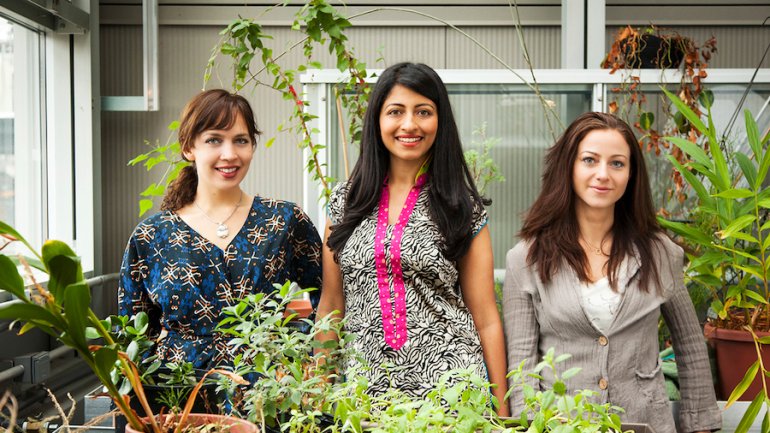Cocktail recipe for this week's American Craft Forum
Our mixologist partner Shoots & Roots Bitters offers a botanical treat – with tips for small-batch sourcing.
↑ Rachel Meyer, Selena Ahmed, and Ashley DuVal, the founders of Shoots & Roots Bitters and authors of Botany at the Bar.
Photo: Courtesy of Roost Books
The inventive team of botanists at Shoots & Roots Bitters is helping shake up our current American Craft Forum series by providing a craft cocktail recipe each week.
The drink for our June 12 forum is loaded with mood-enhancing botanicals, and the Shoots & Roots team has provided a list of small-batch distillers and growers to help us source our ingredients in a sustainable and equitable way.
Ica Shuffle with Damiana Leaf-Infused Pisco and Xocolatl Bitters
By Christian Schaal
Lucuma is a fruit native to Peru. The fresh fruit is similar to egg yolk, but the powdered extract has a delicious sweet raisin flavor. Damiana is a mood-enhancing subtropical herb in the passionflower family that has a cooling figlike flavor. Damiana tends to be bitter when steeped in water or alcohol for a long time. We combined these two South American plants and added yogurt to balance out the flavors. With as much damiana in a drink as possible, it’s a prized aphrodisiac for both men and women.
- 1 ½ oz (45 mL) Damiana Leaf-Infused Pisco (see recipe below)
- ¾ oz (20 mL) Lucuma Simple Syrup (see page 124 in Botany at the Bar for the recipe)
- ½ oz (15 mL) lime juice
- 1 tsp Greek yogurt
- 1 tsp crème de cacao
- 1 dash Xocolatl Bitters (see recipe below)
- Sprig of lavender (for garnish)
Damiana Leaf-Infused Pisco:
Blend ½ tsp dried crushed damiana leaves with 6 oz (175 mL) pisco, let rest for 15 minutes, and strain.
Method:
In a shaker, combine all the ingredients and shake with ice. Double strain into a stemless wine glass with fresh ice. Garnish with a sprig of lavender. Yields one 3 oz drink.
Xocolatl Bitters by Shoots & Roots Bitters:
This is our homage to the world’s earliest known bitter cocoa beverage. Xocolatl, the origin of chocolate, means “bitter water,” but was a drink shared by Kings and Mayan Gods. Note: almond is a replacement for other seeds in the ancient recipe that are psychoactive.
- 4 g black peppercorns
- 2 g whole or ground annatto seeds
- 7 g almond extract (use bitter almond extract if you can get it)
- 30 g cacao powder (unsweetened)
- 2 g chili powder
- 7/8 cup (205 mL) 40% ABV grain alcohol, such as vodka
Method:
Coarsely grind the peppercorns and annatto seeds (if using whole) with a mortar and pestle. Transfer the ingredients along with the cacao and chili to an 8-oz (240-mL) jar, add the alcohol, and seal the jar with the lid. To infuse the ingredients, first shake the jar, then leave it to sit for 1 week, shaking and rotating it daily.
Strain the mixture through a nut milk bag or French press and discard the solids. Bottle the bitters.
Adapted from Botany at the Bar by Selena Ahmed, Rachel Meyer, and Ashley DuVal © 2019 Selena Ahmed, Rachel Meyer, and Ashley DuVal. Reprinted in arrangement with Roost Books, an imprint of Shambhala Publications, Inc. Boulder, Colorado.
About the ingredients
Lucuma Pouteria lucuma (RUIZ & PAV.) KUNTZE
The earliest appearance of lucuma dates from 5,700 to 3,000 BCE Peru, which today is the main source with more than 85 percent of global production. Lucuma has a sweet taste although it is low in sugar; the flesh of the fruit is often processed as a flavoring for ice cream, bakery products, yogurt, and more.
Plant part used: Fruit
Damiana Turnera diffusa WILLD. EX SCHULT.
The Guaycura, a tribe in Baja, were believed to be the first to use damiana in religious ceremonies, and they traded it with the Aztecs as a potent aphrodisiac. Distilleries in southern Baja still use damiana in liqueurs. It is believed to have been an original ingredient of margaritas before triple sec. Damiana is pungent, with figlike notes and a bitter aftertaste.
Plant part used: Leaves
Cacao Theobroma cacao L.
Cacao – chocolate – is native to the upper Amazon and was domesticated by the Mayans. It was used traditionally to treat a range of conditions, but when it arrived in Europe in the late sixteenth century, chocolate was used to treat hot diseases, such as fevers. Its use eventually widened as it was tested within the European medical system of the time.
Plant part used: Seed
Adapted from Botany at the Bar by Selena Ahmed, Rachel Meyer, and Ashley DuVal © 2019 Selena Ahmed, Rachel Meyer, and Ashley DuVal. Reprinted in arrangement with Roost Books, an imprint of Shambhala Publications, Inc. Boulder, Colorado.
Supporting Craft Distillers and Growers through Direct-to-Consumer Ecommerce
Ingredient: Pisco
Source: Macchu Pisco
The only pisco distillery in Peru owned and operated by women. While Macchu Pisco, rated 94 at Ultimate Spirits Challenge, retails locally at TotalWines for just $27, we also can't get enough of their high end bottle Nusta Pisco, with notes of orange blossoms and lemon grass in handcrafted ceramic bottles modeled after Huaco casks of Incan Royalty! Pair with Andean Amargo bitters as featured in our book Botany at the Bar for a thoroughly Andean Pisco recipe.
Source: PiscoLogia
For PiscoLogia, maintaining an artisanal, craft practice means creating livelihoods in the community in Azpitia while ensuring higher quality. Smaller fermentation batches and hand harvesting ensure fermentation by native yeast is optimized, while vineyards are irrigated with surface runoff from the Andes. Distillations are made in a 300L copper pot, making every batch truly unique and distinct.
Ingredient: Crème de Cacao
Source: Tempus Fugit
Tempus Fugit is devoted to reviving rare liquors, using the same techniques and terroirs of the original formulations. They bring this integrity to their Crème de Cacao, sourcing from Venezuela’s renowned fine flavor cacao varietals and Mexican vanilla. Where most brands hide behind natural flavors, here cacao is integral to the process. Raw beans are first distilled, then roasted cacao and crushed vanilla extracted into the distillate directly.
Source: DIY Recipe
In the spirit of craft thinking, never assume there is a single way “how to.” Start with this recipe from Imbibe magazine, and then make it your own!
Ingredient: Damiana
Source: Grow Your Own
If you enjoy the fragrance and mood-boosting effects of damiana, why not cultivate it? Here is an easy tutorial on how to grow the Mexican medicinal herb.
Source: Willow Bends Farm
Bulk damiana can be found from a variety of online sources. For those interested in buying directly from growers, consult with Willow Bends Farm in Dinwiddie, Virginia, a community-oriented farm and kitchen specializing in organic medicinal and culinary herbs, teas, and essential oils.
Ingredient: Lucuma
Source: Ecoandino
Ecoandino is a Peruvian company that follows the tradition of agriculture dedicated to the cultivation, processing, and marketing of ancient superfoods and Andean and Amazonian biodiversity since 1998 – always meeting organic, Fair Trade, Kosher, and Halal standards. Organic lucuma is cultivated by small farmer-associates in Huanta – Ayacucho and Oxapampa – Pasco, Peru.

↑ Photo: Courtesy of Roost Books
About Shoots & Roots Bitters
Shoots & Roots Bitters was founded by Rachel Meyer, Selena Ahmed, and Ashley DuVal – three female scientists that promote biodiversity through research, teaching, and the creation of science-based botanical blends that draw from ecology, cultural practices, and flavors around the world.Deeply valuing collaboration across sectors, their team includes mixologist Christian Schaal, chef Noah ten Broek, and artist Joren Eulalee.

This week's recipe stems from Shoots & Roots' book Botany at the Bar: The Art & Science of Making Bitters. Get 20 percent off and free shipping on this title when you buy from Roost Books. Use promo code BRIGHTEN.

